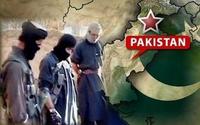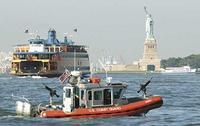-
Regulators: N.J. nuclear plant employee was an Islamic jihadist

A 26-year old American, Sharif Mobley, now under arrest in Yemen for terrorist activities, became an Islamic militant while working for six years at several nuclear plants in New Jersey, Pennsylvania, and Maryland; the man — who told fellow workers “We are brothers in the union, but if a holy war comes, look out” — had unescorted access to the interior of the plants; to have unescorted access to secure areas of a nuclear power plant, a person must undergo a background investigation, including a criminal record check and a psychological assessment — but the rules did not account for temporary workers who migrate from plant to plant, as Mobley did
-
-
Voice biometrics help detect Euro terror plot
Western intelligence services say that the discovery of the recent Euro terror plot owes at least some of its success to voice recognition technology that allows law enforcement electronically to match a voice to its owner; the technique can be an effective antiterror tool, and law enforcement agencies are already considering how a voice database could help thwart future plots
-
-
Missing links unveiled?
Two years ago a high-level Syrian general was killed; are we getting closer to the truth about the operation that led to his assassination? Also: Musharaf speaks about the past — but what about the future?
-
-
U.S. intelligence: Europe terror plot did not target Americans

U.S. intelligence says the latest threat did not appear to involve the United States; possible targets of the plot included several tourist attractions across Paris and Berlin. ABC News reported Monday that at least five European airports could be targeted as well; the list of possible targets includes the Eiffel Tower in Paris and the luxury Hotel Adlon near Berlin’s Brandenburg Gate, the Notre Dame Cathedral in Paris, as well as Berlin’s Central Station and its landmark Alexanderplatz TV tower; one official said security has also been tightened around the British royal family
-
-
Evolving terrorist threat: home-grown radicalized Western Muslims to the fore
The relentless attacks by U.S. drones — and, away from the headlines, U.S. special forces — on militants’ hideouts in Pakistan — and also, to an extent, the half-hearted, pick-and-choose-among-militants campaign by the Pakistani military — have forced al Qaeda to rely more and more on home-grown, radicalized Islamists in Western countries for terrorist actions instead of militants from Muslim countries
-
-
Number of extremist, hard-to-police Web sites skyrockets
The number of extremist Web sites has skyrocketed, expanding from 12 in 1998 to 4,500 in 2006; Western authorities say that taking action to remove them remains difficult; different countries have adopted different approaches to the problem
-
-
Pakistan: Several dozens of Europeans in terror training in Pakistan

Pakistan, Western intelligence agencies say several dozens Muslim militants with European citizenship are believed to be hiding out in the lawless tribal area of northwestern Pakistan, training for missions that could include terror attacks in European capitals; among the militants are at least twenty British and twenty German citizens; the groups voice-printing software enables British intelligence to identify and track specific individuals believed connected to terror plots; mobile phone communications have been tracked from the border area to points in Britain, particularly England’s Midlands, where there is a heavy Pakistani immigrant population
-
-
Mumbai-like terror attack on European cities foiled
Al Qaeda- and Taliban-affiliated terrorists based in Pakistan planned a Mumbai-like attack on London and other European cities; experts say the plot is believed to have moved from the aspirational stage to actual planning; rather than set up explosives to blow up buildings, the terrorists would have used machine-guns and hand grenades to kill as many people as possible; improved Western intelligence capabilities made Western authorities aware of the plot, and as the organizers of the attack and the militants who were to carry it out gathered in Pakistan for training and last-minute instructions, a barrage of precise missile attacks from CIA drones — some 20 sorties in all — killed many of the plotters and disrupted their preparations
-
-
U.S. officials: terror threat against U.S. diversifying

The terrorism threat against the United States has evolved, with homegrown terrorists and a greater diversity in the scope and methods of attack making it more difficult to prevent them, top security officials told a Senate committee Wednesday; the number of terrorist attacks against the United States increased in the past fifteen months; Napolitano said the nature of terrorist attacks continues to evolve, with recent attacks coming faster and with “less extensive pre-operational planning than previous attempts and with fewer linkages to international terrorist organizations”
-
-
Freed Pope plot suspects may sue police for false arrest

U.K. police and counterterrorism authorities are worried that the six men who were arrested Friday on suspicion that they were plotting to assassinate the Pope during his U.K. visit may take legal action for unlawful arrest and detention; the men, all of North African origin, were released Saturday and Sunday after police admitted there was no evidence of a plot
-
-
Resurgent Irish terrorism on agenda North and South
Irish politicians on both sides of the border say resurgent Republican terrorism is a growing problem; tensions grown as community leaders charge that the Northern Irish police have turned a blind eye to the killing of a Belfast man by the Protestant Ulster Volunteer Force (UVF); intelligence sources say the UVF leadership authorized the killing because the man “had flouted their authority”
-
-
Australia: "high risk" of terrorism at Commonwealth Games in India
Australia says there is a “high risk of terrorist attack” in New Delhi as the Indian capital prepares to host the Commonwealth Games, scheduled for 3-14 October; the U.S. State Department issued a travel alert on 1 September urging U.S. citizens to be cautious of their security if they travel to India during the Games
-
-
Delhi proposes unprecedented security at Commonwealth games
The security measures India has put in place for the Commonwealth Games surpass those instituted for Delhi’s Independence Day and Republic Day; in all, the Games will be secured by more than 80,000 Delhi police personnel, 17,500 paramilitary personnel, 3,000 commandos, 100 anti-sabotage teams, more than 200 dogs, and 15 bomb squads
-
-
British man arrested at Amsterdam airport on terrorism suspicion

A British man of Somali ancestry was arrested in Amsterdam’s Schiphol airport for possible links to a terrorist group; the suspect is allegedly linked to Somalia’s most dangerous militant group, al Shabab; militant veterans of the Iraq and Afghanistan conflicts help train al Shabab fighters, one of the reasons the sophistication of its attacks has risen in recent months; the al Qaeda-linked group in the past has recruited Somali-Americans to carry out suicide bombings in Mogadishu
-
-
Six freed over suspected Pope plot
U.K. police released the six men arrested Friday on suspicion that they plotted to kill the Pope during his U.K. visit; the police, after a thorough search of the homes of the suspects — all men of North African origin — and interviews with neighbors, the police said the men posed no credible threat; one newspaper reports that the men were arrested after been overheard sharing a joke in their canteen; the six all work for Veolia Environmental Services, a contractor which employs 650 on-street staff to keep the streets of Westminster clean
-
More headlines
The long view
What Does Netflix’s Drama “Adolescence” Tell Us About Incels and the Manosphere?
While Netflix’s psychological crime drama ‘Adolescence’ is a work of fiction, its themes offer insight into the very real and troubling rise of the incel and manosphere culture online.
